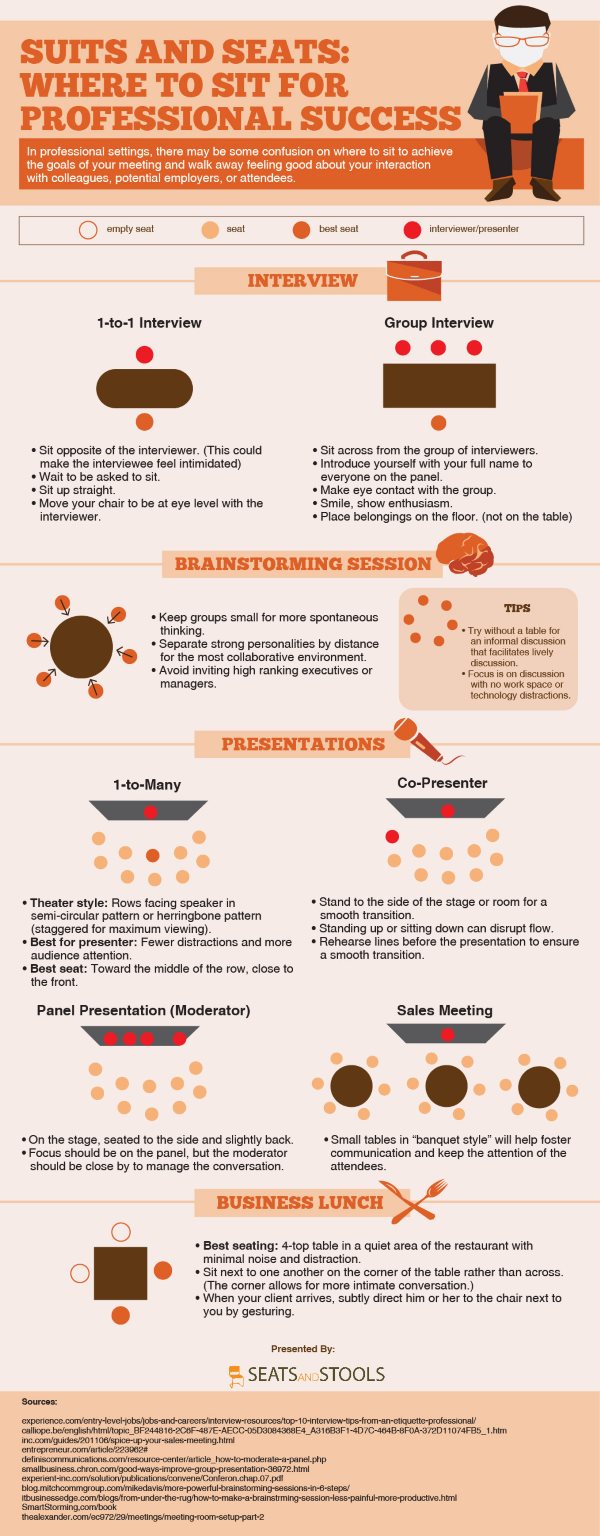Can Where I Choose to Sit Affect my Professional Success?

With so many different tips and tricks, sometimes it can be overwhelming trying to master the “perfect” formula and approach for interviewing success.
We all know the universal rules of arriving at least 15 minutes early and following up after an interview just to reiterate your interest (along with thanking the interviewer for his/her time). And we’re all aware of how our appearance and body language can leave positive or negative impressions with hiring managers, ultimately affecting our employment success.
But, did you know that besides the research, and showing up on time, and speaking with confidence, there is another area that could affect how successful you are during an interview—something most of us wouldn’t even consider?
According to furniture manufacturer Seats and Stools, candidates should consider this before their next interview: Where should you sit?
The company has created an infographic, Suits and Seats: Where to Sit for Professional Success, which explains the relation between seats and professional business outcomes. And Seats and Stools even broke it down into four different business “sitting scenarios.”
Let’s take a look at how your seat can affect your professional life:
Interviews
One-on-one interviews
In a one-on-one interview scenario, the infographic advises you to sit opposite of the interviewer, which could make him/her feel intimidated. Candidates should wait to be asked to sit, and when they are seated, don’t forget to sit up straight. The infographic advises to move your chair to be at eye level with the interviewer.
Group interviews
If you are interviewing with a group or panel, sit across from the group of interviewers. The infographic shows the best seat is directly in the middle if there are three people on the interview panel.
The visual says to introduce yourself by giving your full name to everyone on the panel, make eye contact with the group, smile and show enthusiasm. Also, place your belongings on the floor, not the table.
I agree with the point about introducing yourself to everyone. Once when I interviewed with a panel of three, I made it a point to introduce myself and shake each interviewer’s hand when I walked into the room. I could tell each person was impressed with this gesture.
Brainstorming Session
When your team in brainstorming, the infographic believes you should keep groups small for spontaneous thinking.
The infographic has seats in a circle, advising to try creating a brainstorming circle of seats without a table for an informal group discussion that facilitates lively discussion. And don’t forget to separate strong personalities by distance when placing chairs in this type of seating scenario.
Presentations
One-to-many
Presentations are a form of business communication that many of us will encounter. The infographic says to arrange seats in theater style with rows facing the speaker in a semi-circular pattern or herringbone pattern. Make sure you stagger the seats for maximum viewing.
This setup, the infographic explains, is best for the presenter because there are fewer distractions and allows the audience to pay more attention. The best seat to sit in during a one-to-many presentation is toward the middle of the row and close to the front (typical “best seat” when going to an actual movie theater).
Sales Meeting
During a sales meeting, the presenter should be at the front while the audience is at small tables. This “banquet style” approach to a sales meeting will help foster communication and keep the attention of the attendees.
Business Lunch
Now, business lunches are extremely common—but according to the infographic—most of us who give no thought to where we or our clients sit may be missing out on the opportunity for maximum communication success. The best seating for a business lunch is a 4-top table in the quiet area of a restaurant with minimal noise and distractions, the infographic explains.
If you and a colleague are hosting the lunch, sit next to each other on the corner of the table rather than across from each other. This way, according to the visual, both of you can have a client seated on the other corner next to you, allowing for intimate conversation. The infographic advises to subtly direct your client to the chair next to you once he or she arrives.
I must admit, where I choose to sit affecting my professional life is an idea that never occurred to me before seeing this infographic. Yet, after viewing it, I can understand how one’s seat can either hurt or help him/her in different business communication settings.
What do you think? Is your choice of seat really a factor in professional business communication success?


